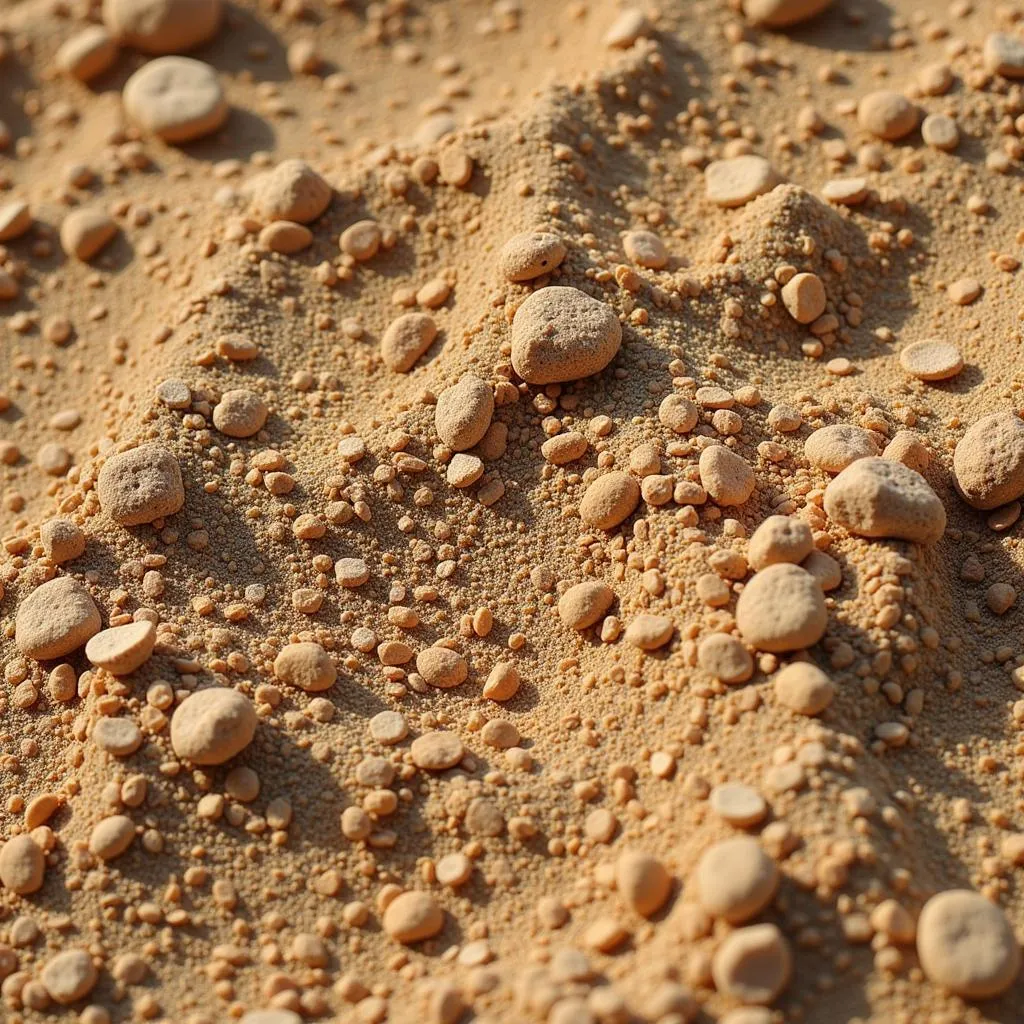Choosing the Best Food Plot Seed For Sandy Soil can feel like a gamble. Sandy soil, notorious for its poor water and nutrient retention, presents unique challenges for food plot enthusiasts. But don’t despair! With the right knowledge and seed selection, you can transform your sandy terrain into a thriving food source for wildlife.
This comprehensive guide will equip you with the tools and insights needed to make informed decisions about the best food plot seed for your sandy soil. Let’s dig in!
Understanding Sandy Soil and its Challenges
Before we delve into the best food plot seeds, it’s crucial to understand the characteristics of sandy soil and the obstacles it presents. Imagine holding a handful of sand – notice how easily it flows through your fingers? This loose structure, while offering good drainage, makes it difficult for the soil to retain moisture and essential nutrients crucial for plant growth.
 Close-up view of sandy soil texture
Close-up view of sandy soil texture
Key Factors When Choosing Seeds for Sandy Soil
Selecting the right food plot seed for sandy soil involves considering several factors:
- Drought Tolerance: Opt for seeds of plant species known for their ability to thrive in dry conditions. These plants have adapted mechanisms to survive and produce even with limited water availability.
- Nutrient Requirements: Look for seeds of plants that are less demanding in terms of nutrient needs. Legumes, for example, can fix nitrogen from the air, reducing the reliance on soil fertility.
- Root System: Deep-rooted plants are particularly advantageous in sandy soil. Their extensive root systems can reach deeper layers, tapping into moisture reserves that surface-rooted plants can’t access.
- pH Adaptability: Sandy soils tend to be acidic. Choose seed varieties that tolerate or prefer acidic pH levels.
Top Food Plot Seed Options for Sandy Soil
Here are some of the best food plot seed options that can thrive in sandy soil conditions:
1. Cowpeas
Cowpeas, a type of legume, top the list for their resilience in poor soil conditions, including sand. They boast excellent drought tolerance and can even improve soil fertility by fixing nitrogen. Their high protein content makes them a favored food source for deer, turkey, and other wildlife.
2. Lablab
Lablab, another excellent legume option, demonstrates exceptional heat and drought tolerance. This fast-growing, vining plant produces an abundance of leafy forage and protein-rich seeds. Its ability to thrive in poor soils and withstand harsh conditions makes it a winner for sandy soil food plots.
3. Alyceclover
Alyceclover, a warm-season annual legume, offers excellent drought tolerance and thrives in sandy soils. It provides valuable forage for deer and other wildlife, especially during the late summer months when other food sources might be scarce.
 White-tailed deer grazing in a lush food plot
White-tailed deer grazing in a lush food plot
4. Sorghum
Known for its hardiness, sorghum can handle drought conditions effectively. This fast-growing, heat-loving annual produces a substantial amount of forage and grain, making it attractive to various wildlife species, including deer, turkey, and quail.
5. Buckwheat
Buckwheat, a fast-growing, broadleaf annual, acts as a fantastic cover crop and attracts pollinators. It thrives in poor soils, including sandy soil, and can even suppress weed growth. While not a preferred food source, it can provide supplemental forage for deer and other wildlife.
6. Turnips
While not as drought-tolerant as other options, turnips can still perform well in sandy soil, especially when planted in areas with some moisture retention. They offer a high nutritional value for deer and other wildlife, particularly during the fall and winter months.
Tips for Successful Food Plot Planting in Sandy Soil
- Soil Testing: Before you plant, get a soil test to determine the pH and nutrient levels. This information will guide you in adjusting the soil appropriately for optimal plant growth.
- Soil Amendment: Incorporating organic matter like compost or aged manure can significantly improve sandy soil’s water and nutrient retention capacity.
- Proper Planting Depth: Follow the recommended planting depth for your chosen seed. Planting too deep in sandy soil can hinder germination.
- Weed Control: Implement effective weed control measures, as weeds compete with food plot seedlings for essential resources.
- Irrigation (If Possible): While selecting drought-tolerant seeds is key, providing supplemental irrigation during establishment, especially in extremely dry periods, can significantly boost your food plot’s success.
Reaping the Rewards of a Thriving Food Plot
Successfully establishing a flourishing food plot in sandy soil is a rewarding endeavor. Not only does it provide a valuable food source for wildlife, but it also enhances habitat and attracts various species, creating an enriching ecosystem in your backyard.
Remember, choosing the best food plot seed for sandy soil is the first step. Combining the right seed selection with proper soil preparation and management techniques will increase your chances of success.
For more information on creating thriving food plots, explore our comprehensive guides on corn seed for food plots and food plots for sandy soil.
Frequently Asked Questions
1. Can I plant a food plot directly into sandy soil?
While possible, amending sandy soil before planting is highly recommended. Incorporating organic matter improves its water and nutrient retention, significantly boosting your food plot’s success.
2. When is the best time to plant food plots in sandy soil?
The ideal planting time depends on your chosen seed and your region’s climate. Generally, spring or early fall plantings are suitable for most food plot seeds in sandy soil.
3. How do I control weeds in my sandy soil food plot?
Employing weed control measures like mulching, hand-weeding, or using appropriate herbicides can help manage weed pressure in your food plot.
4. What should I do if my sandy soil food plot isn’t thriving?
Several factors could contribute to a struggling food plot. Consider soil testing, adjusting irrigation practices, reviewing planting techniques, and ensuring adequate weed control.
5. Where can I find additional resources for food plot establishment?
Numerous online resources, local agricultural extension offices, and experienced food plot enthusiasts can offer valuable insights and guidance.
Need personalized assistance with your food plot project? Contact us at Phone Number: 02437655121, Email: [email protected] Or visit us at: 3PGH+8R9, ĐT70A, thôn Trung, Bắc Từ Liêm, Hà Nội, Việt Nam. Our dedicated customer support team is available 24/7 to help you achieve success!